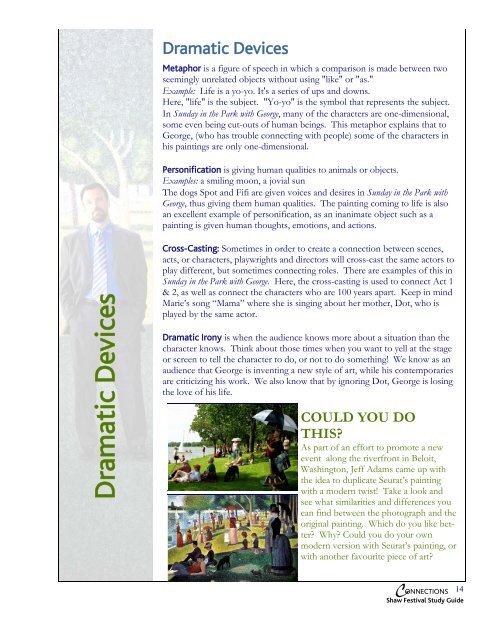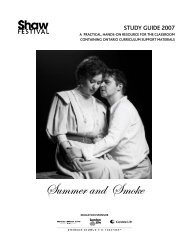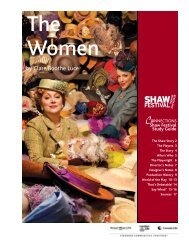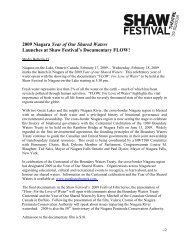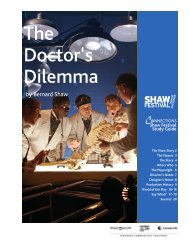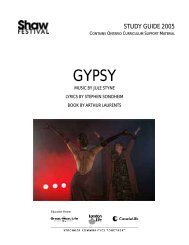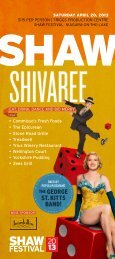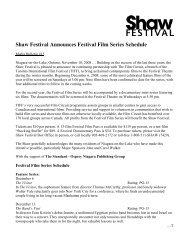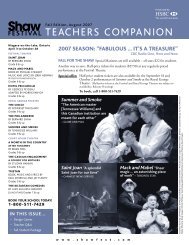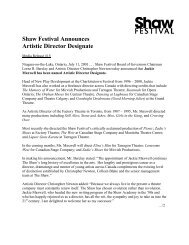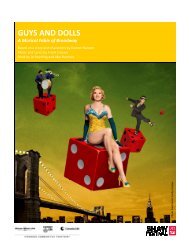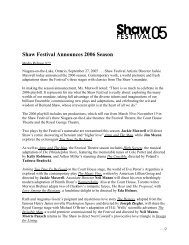Sunday in the Park with George Music and Lyrics by Stephen ...
Sunday in the Park with George Music and Lyrics by Stephen ...
Sunday in the Park with George Music and Lyrics by Stephen ...
You also want an ePaper? Increase the reach of your titles
YUMPU automatically turns print PDFs into web optimized ePapers that Google loves.
Dramatic Devices<br />
Metaphor is a figure of speech <strong>in</strong> which a comparison is made between two<br />
seem<strong>in</strong>gly unrelated objects <strong>with</strong>out us<strong>in</strong>g "like" or "as."<br />
Example: Life is a yo-yo. It's a series of ups <strong>and</strong> downs.<br />
Here, "life" is <strong>the</strong> subject. "Yo-yo" is <strong>the</strong> symbol that represents <strong>the</strong> subject.<br />
In <strong>Sunday</strong> <strong>in</strong> <strong>the</strong> <strong>Park</strong> <strong>with</strong> <strong>George</strong>, many of <strong>the</strong> characters are one-dimensional,<br />
some even be<strong>in</strong>g cut-outs of human be<strong>in</strong>gs. This metaphor expla<strong>in</strong>s that to<br />
<strong>George</strong>, (who has trouble connect<strong>in</strong>g <strong>with</strong> people) some of <strong>the</strong> characters <strong>in</strong><br />
his pa<strong>in</strong>t<strong>in</strong>gs are only one-dimensional.<br />
Personification is giv<strong>in</strong>g human qualities to animals or objects.<br />
Examples: a smil<strong>in</strong>g moon, a jovial sun<br />
The dogs Spot <strong>and</strong> Fifi are given voices <strong>and</strong> desires <strong>in</strong> <strong>Sunday</strong> <strong>in</strong> <strong>the</strong> <strong>Park</strong> <strong>with</strong><br />
<strong>George</strong>, thus giv<strong>in</strong>g <strong>the</strong>m human qualities. The pa<strong>in</strong>t<strong>in</strong>g com<strong>in</strong>g to life is also<br />
an excellent example of personification, as an <strong>in</strong>animate object such as a<br />
pa<strong>in</strong>t<strong>in</strong>g is given human thoughts, emotions, <strong>and</strong> actions.<br />
Dramatic Devices<br />
Cross-Cast<strong>in</strong>g: Sometimes <strong>in</strong> order to create a connection between scenes,<br />
acts, or characters, playwrights <strong>and</strong> directors will cross-cast <strong>the</strong> same actors to<br />
play different, but sometimes connect<strong>in</strong>g roles. There are examples of this <strong>in</strong><br />
<strong>Sunday</strong> <strong>in</strong> <strong>the</strong> <strong>Park</strong> <strong>with</strong> <strong>George</strong>. Here, <strong>the</strong> cross-cast<strong>in</strong>g is used to connect Act 1<br />
& 2, as well as connect <strong>the</strong> characters who are 100 years apart. Keep <strong>in</strong> m<strong>in</strong>d<br />
Marie’s song “Mama” where she is s<strong>in</strong>g<strong>in</strong>g about her mo<strong>the</strong>r, Dot, who is<br />
played <strong>by</strong> <strong>the</strong> same actor.<br />
Dramatic Irony is when <strong>the</strong> audience knows more about a situation than <strong>the</strong><br />
character knows. Th<strong>in</strong>k about those times when you want to yell at <strong>the</strong> stage<br />
or screen to tell <strong>the</strong> character to do, or not to do someth<strong>in</strong>g! We know as an<br />
audience that <strong>George</strong> is <strong>in</strong>vent<strong>in</strong>g a new style of art, while his contemporaries<br />
are criticiz<strong>in</strong>g his work. We also know that <strong>by</strong> ignor<strong>in</strong>g Dot, <strong>George</strong> is los<strong>in</strong>g<br />
<strong>the</strong> love of his life.<br />
COULD YOU DO<br />
THIS?<br />
As part of an effort to promote a new<br />
event along <strong>the</strong> riverfront <strong>in</strong> Beloit,<br />
Wash<strong>in</strong>gton, Jeff Adams came up <strong>with</strong><br />
<strong>the</strong> idea to duplicate Seurat’s pa<strong>in</strong>t<strong>in</strong>g<br />
<strong>with</strong> a modern twist! Take a look <strong>and</strong><br />
see what similarities <strong>and</strong> differences you<br />
can f<strong>in</strong>d between <strong>the</strong> photograph <strong>and</strong> <strong>the</strong><br />
orig<strong>in</strong>al pa<strong>in</strong>t<strong>in</strong>g. Which do you like better?<br />
Why? Could you do your own<br />
modern version <strong>with</strong> Seurat’s pa<strong>in</strong>t<strong>in</strong>g, or<br />
<strong>with</strong> ano<strong>the</strong>r favourite piece of art?<br />
14<br />
C<br />
ONNECTIONS<br />
Shaw Festival Study Guide


